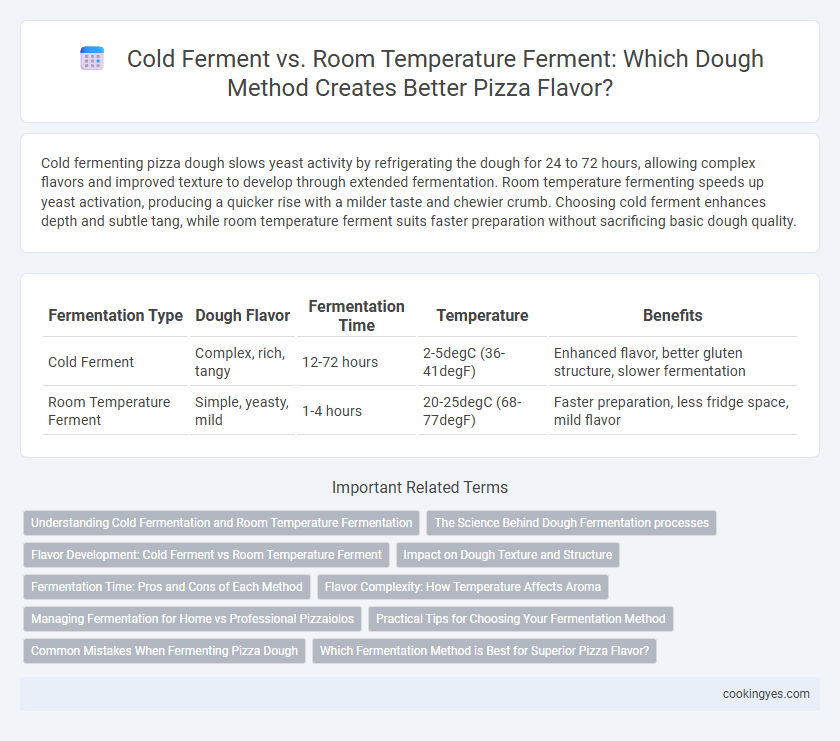Cold fermenting pizza dough slows yeast activity by refrigerating the dough for 24 to 72 hours, allowing complex flavors and improved texture to develop through extended fermentation. Room temperature fermenting speeds up yeast activation, producing a quicker rise with a milder taste and chewier crumb. Choosing cold ferment enhances depth and subtle tang, while room temperature ferment suits faster preparation without sacrificing basic dough quality.
Table of Comparison
| Fermentation Type | Dough Flavor | Fermentation Time | Temperature | Benefits |
|---|---|---|---|---|
| Cold Ferment | Complex, rich, tangy | 12-72 hours | 2-5degC (36-41degF) | Enhanced flavor, better gluten structure, slower fermentation |
| Room Temperature Ferment | Simple, yeasty, mild | 1-4 hours | 20-25degC (68-77degF) | Faster preparation, less fridge space, mild flavor |
Understanding Cold Fermentation and Room Temperature Fermentation
Cold fermentation slows yeast activity by maintaining dough at 35-40degF (2-4degC), allowing complex flavor compounds to develop over 24-72 hours, resulting in enhanced acidity and a deeper, more nuanced taste. Room temperature fermentation occurs between 70-75degF (21-24degC), speeding yeast metabolism to produce a lighter, more yeast-forward flavor profile within 3-8 hours. Mastering the differences in fermentation temperature impacts gluten structure, dough extensibility, and ultimately the balance between flavor complexity and rise time in pizza crust.
The Science Behind Dough Fermentation processes
Cold ferment slows yeast activity, allowing enzymes to break down starches into simpler sugars, resulting in enhanced dough flavor and improved texture. Room temperature ferment accelerates yeast fermentation, producing a more robust rise but less complex flavor development due to shorter enzymatic action. The balance between temperature and time in fermentation directly influences gluten structure, sugar availability, and flavor compounds in pizza dough.
Flavor Development: Cold Ferment vs Room Temperature Ferment
Cold ferment enhances pizza dough flavor by allowing slow yeast activity over 24 to 72 hours, producing complex organic acids and alcohols that create a rich, tangy taste. Room temperature ferment accelerates yeast fermentation within 1 to 3 hours, resulting in a lighter, more straightforward flavor profile with less depth. The extended cold fermentation process contributes to better gluten development and a chewier texture, while room temperature ferment prioritizes speed over intricate flavor complexity.
Impact on Dough Texture and Structure
Cold ferment enhances dough texture by slowing yeast activity, allowing enzymes to break down starches and proteins, resulting in a chewier crust with complex flavor development. Room temperature ferment accelerates fermentation, producing a lighter, airier dough structure but with less nuanced taste. The choice between cold and room temperature ferment dramatically influences gluten network strength and crumb openness in pizza dough.
Fermentation Time: Pros and Cons of Each Method
Cold ferment extends the fermentation time from 24 to 72 hours, allowing enzymes to break down starches and proteins fully, resulting in a more complex, tangy dough flavor. Room temperature ferment is faster, typically 1 to 4 hours, producing a softer, yeastier taste but with less depth in flavor development. Cold fermentation offers improved dough texture and enhanced flavor complexity, while room temperature fermentation speeds up preparation but may result in a blander crust.
Flavor Complexity: How Temperature Affects Aroma
Cold fermentation enhances pizza dough's flavor complexity by slowing yeast activity, allowing organic acids and alcohols to develop more nuanced aromas over several days. Room temperature fermentation accelerates fermentation, producing a brighter, yeast-driven aroma but with less depth in flavor layers. Temperature directly influences the balance of esters and aldehydes, which are key compounds contributing to the dough's distinctive aroma profile.
Managing Fermentation for Home vs Professional Pizzaiolos
Cold ferment significantly enhances dough flavor by slowing yeast activity, allowing complex organic acids and alcohols to develop over 24 to 72 hours, ideal for professional pizzaiolos aiming for depth and consistency. Room temperature ferment accelerates yeast activity, producing a quicker rise within 2 to 6 hours but less nuanced flavors, preferred by home cooks for convenience. Managing fermentation time and temperature precisely impacts dough texture and taste, with controlled cold fermentation offering superior results in a professional setting, while room temperature fermentation suits casual, time-sensitive baking.
Practical Tips for Choosing Your Fermentation Method
Cold ferment enhances dough flavor by slowing yeast activity, allowing complex, tangy notes to develop over 24-72 hours in the refrigerator. Room temperature ferment is faster, typically 2-6 hours, producing a milder flavor ideal for same-day baking or softer crusts. Opt for cold ferment when seeking depth and chewiness, and choose room temperature ferment for quick preparation and a lighter, airy texture.
Common Mistakes When Fermenting Pizza Dough
Overproofing pizza dough at room temperature often results in a sour taste and weakened gluten structure, compromising the crust's texture. Neglecting to control fermentation time in cold ferment can lead to underdeveloped flavors and dense dough. Ensuring precise temperature control and timing during fermentation is crucial to achieve the ideal balance of flavor and dough elasticity.
Which Fermentation Method is Best for Superior Pizza Flavor?
Cold ferment enhances dough flavor by allowing slow yeast activity over 24 to 72 hours in the refrigerator, developing complex, tangy notes and a chewier texture ideal for artisanal pizzas. Room temperature ferment accelerates yeast fermentation within 2 to 4 hours, producing a milder flavor and softer crust but sacrificing depth and aroma. For superior pizza flavor with balanced acidity and rich gluten structure, cold fermentation is the preferred method among professional pizzaiolos.
Cold Ferment vs Room Temperature Ferment for dough flavor Infographic

 cookingyes.com
cookingyes.com